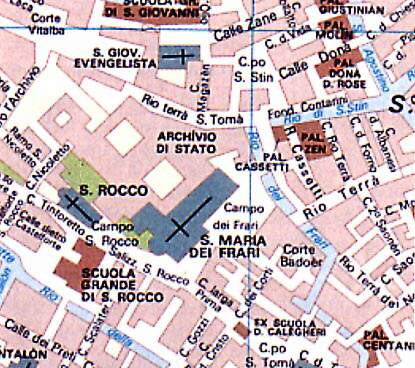
Map oriented to north with
Frari in the middle.
(Jpg: Chiese
di Venezia)
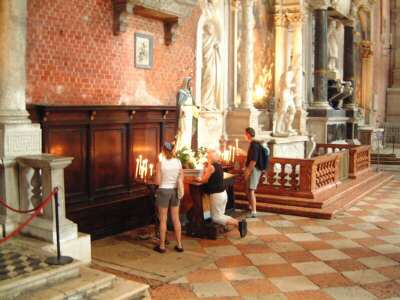
View
interior, small alters some
of the prominent families commissioned works of art within the church and
built alters and chapels for the glory of God (and the private use of their
own family). Along this wall you can see (at least in part) five separate
alters. Just imagine the church full of these.
John
Singer Sargent

Sketch
after -- Monument to Benedetto Brugnolo da Legnago, Church of Santa Maria
Gloríosa dei Frari, Venice
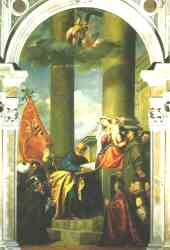
The
Madonna di Ca' Pesaro
Pesaro
altarpiece
| "In
the same church, for the chapel of the Pesari family, he painted a picture
of the Madonna with her Son in her arms, and St Peter and St George; and
round about are the patrons of the work; they include the bishop of Paphos
and his brother, just returned from the victory which the bishop had won
against the Turks." (Giorgio Vasari, I-449) |


LOMBARDO,
Antonio
Monument
to Bishop Jacopo Pesaro
before
1524
Marble
Santa
Maria Gloriosa dei Frari, Venice

SANSOVINO,
Jacopo
St
John the Baptist
1554
Marble
Santa
Maria Gloriosa dei Frari, Venice

DONATELLO
St
John the Baptist
1438
Wood,
height: 141 cm
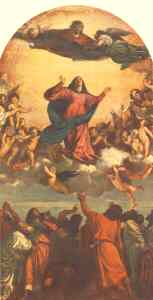
"Titian
painted an altarpiece for the high altar showing Our Lady ascending into
heaven and below her are the twelve apostles who are watching as she ascends."
(Giorgio Vasari, The Lives of the Most Excellent Painters, Sculptors
and Architects, 1550, I-449, quoted from the Giorgio
Vasari pages)

VITTORIA,
Alessandro
St
Jerome
1565
Marble
Santa
Maria Gloriosa dei Frari, Venice
John
Singer Sargent
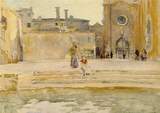
John
Singer Sargent painted the exterior courtyard in 1880 |
|
Photo: Santa Maria Gloriosa
del Frari
Jpg:
Philip
Resheph
The Photo view is looking southwest
from canal.
From Timeout.com
A huge,
gloomy Gothic barn, the brick house of God known officially as Santa Maria
Gloriosa dei Frari may not be the most elegant church in Venice, but it
is certainly one of the city's most significant artistic storehouses after
the Accademia and the Scuola di San Rocco. The Franciscans were granted
the land in about 1250 and they completed a first church in 1338. At this
point they changed their minds and started work on a larger building, facing
the opposite way, which was finally completed just over a century later.
The church is 98m long, 48m wide at the transept and 28m high - just slightly
smaller than San Giovanni e Paolo - and has the second highest campanile
in the city. And while the Frari may not have as many dead Doges as its
Dominican rival, it undoubtedly has the artistic edge.
This is one church
where the entrance fee is not a recent imposition; tourists have been paying
to get into the Frari for over a century. Entrance is via the left transept,
but it's best to begin your visit from the back, where you can enjoy the
long view of the building, with Titian's Assumption above the High Altar
acting as a focus.
Left
aisle
Another magnificent
Titian hangs to the left of the side-door: The Madonna di Ca' Pesaro  .
This work was commissioned by Bishop Jacopo Pesaro in 1519 and celebrates
victory in a naval expedition against the Turks led by the bellicose cleric
in 1502. The Bishop is kneeling and waiting for St Peter to introduce him
and his family to the Madonna. Behind, an armored warrior bearing a banner
has Turkish prisoners in tow. .
This work was commissioned by Bishop Jacopo Pesaro in 1519 and celebrates
victory in a naval expedition against the Turks led by the bellicose cleric
in 1502. The Bishop is kneeling and waiting for St Peter to introduce him
and his family to the Madonna. Behind, an armored warrior bearing a banner
has Turkish prisoners in tow.
This work
revolutionized altar-paintings in Venice. It wasn't just that Titian dared
to move the Virgin from the centre of the composition to one side, using
the splendid banner as a counterbalance; the real innovation was the rich
humanity of the whole work, from the beautifully portrayed family (with
the boy turning to stare straight at us) to the Christ child, so naturally
active and alive, twisting away from his mother (apparently a portrait
of Titian's own wife) to gaze at the clustered saints around him. The timeless
`sacred conversation' of Bellini's paintings here becomes animated, losing
some of its sacredness but gaining in drama and realism.
The whole of the
next bay, around the side door, is occupied by another piece of Pesaro
propaganda - the mastodontic Mausoleum of Doge Pesaro (died 1659) ,
attributed to Longhena, with recently restored sculptures by Melchior Barthel
of Dresden. Even the most ardent fans of the baroque have trouble defending
this one, with its blackamoor caryatides, bronze skeletons and posturing
allegories; political incorrectness is the least of its faults. It seems
impossible for false taste and base feeling to sink lower,' wrote Ruskin,
and you can see his point. ,
attributed to Longhena, with recently restored sculptures by Melchior Barthel
of Dresden. Even the most ardent fans of the baroque have trouble defending
this one, with its blackamoor caryatides, bronze skeletons and posturing
allegories; political incorrectness is the least of its faults. It seems
impossible for false taste and base feeling to sink lower,' wrote Ruskin,
and you can see his point.
The penultimate
bay harbours a Monument to Canova, carried out by his pupils in 1827, five
years after his death, using a design of his own, intended for the tomb
of Titian. His body is buried in his native town of Possagno, but his heart
is conserved in an urn inside the monument. The despondent winged lion
has a distinct resemblance to the one in The Wizard of Oz.
Left
Transept
In the third chapel,
with its altarpiece by Bartolomeo Vivarini and Marco Basaiti, a slab on
the floor marks the grave of the father of opera, Claudio Monterverdi.
The Corner Chapel, at the end of the transept, contains a mannered statue
of St John the Baptist by Sansovino ; this sensitively wistful figure
could hardly be more different from Donatello's work of a century earlier   [John Singer Sargent would sketch Donatello's work on one of his visits].
[John Singer Sargent would sketch Donatello's work on one of his visits].
Notes:
-
Titian
(tsh´n), c.1490–1576,
Venetian painter, whose name was Tiziano Vecellio, b. Pieve di Cadore in
the Dolomites. Of the very first rank among the artists of the Renaissance,
Titian had an immense influence on succeeding generations of painters,
especially in his use of color.
-
More on the Frari
See Overview
of Venice
|
|
